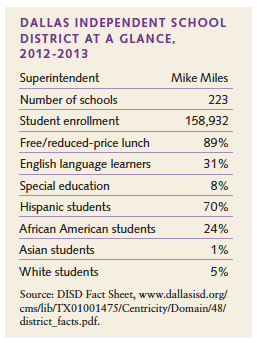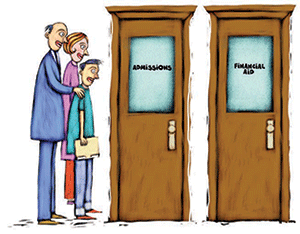Putting College and Career Readiness at the Forefront of District Priorities in Dallas
With college readiness at the center of district priorities, Dallas has made strides in measuring and understanding the role that schools play in students’ knowledge of how to navigate the college experience.
Dallas Independent School District’s (ISD) efforts to develop a system of college readiness indicators began in 2008, when we received a Bill & Melinda Gates Foundation grant under the foundation’s College-Ready Education initiative. With this grant, Dallas ISD’s Performance Management and Analytics department developed a college readiness measurement model, as well as a dashboard and other data-driven measurement tools that would enable principals, teachers, and counselors to gauge the college readiness of their students.
The college readiness measurement model, based on the work of the University of Chicago Consortium for Chicago School Research and David Conley’s Education Policy Improvement Center, emphasized students’ content knowledge, cognitive strategies, academic behaviors, and college context skills. The model also considered the college-going culture of schools and students’ progress in college, as measured by data from the National Student Clearinghouse (NSC).1 Dallas ISD has received NSC data and reports since 2006. Although we had extensive data on student content knowledge, as measured by grades and various assessments, the model identified a need for data on cognitive strategies, academic behaviors, and context skills and awareness.
 In 2010, we began work on a longitudinal diagnostic study of college readiness and success. The study, completed in 2011, analyzed data on more than 75,000 high school graduates spanning the years 1998 through 2009. We found that although more than 50 percent of our district’s graduates enroll in college some time after high school, only 15 percent completed some kind of degree or certificate. We knew this was unacceptably low and that we had a lot of work to do to prepare our students for the demands of the twenty-first-century economy.
In 2010, we began work on a longitudinal diagnostic study of college readiness and success. The study, completed in 2011, analyzed data on more than 75,000 high school graduates spanning the years 1998 through 2009. We found that although more than 50 percent of our district’s graduates enroll in college some time after high school, only 15 percent completed some kind of degree or certificate. We knew this was unacceptably low and that we had a lot of work to do to prepare our students for the demands of the twenty-first-century economy.
In 2011, Dallas ISD’s college readiness work continued when the district became one of the sites for the work of the College Readiness Indicator Systems (CRIS) project.2
Addressing early challenges
Our first challenge was keeping the CRIS work alive and on the agenda of district leadership. We kicked off our efforts in April 2011, hosting the first cross-site convening, unveiling the results of our longitudinal study, and gaining the support of our then-superin- tendent, Michael Hinojosa. Our Performance Management and Analytics department had big plans for new data, indicators, and measurement tools.
But a series of setbacks arose. Michael Hinojosa left Dallas after six years, followed by other district leaders. Much of the interim leadership knew little about the CRIS initiative. Deep budget cuts by the Texas Legislature in 2011 led to widespread layoffs, followed by a district reorganization that eliminated the Performance Management and Analytics department.
Fortunately, the CRIS initiative found a new life in our Evaluation and Assessment department, where our district’s assessment and NSC data resided. Cecilia Oakeley, assistant superintendent for evaluation and assessment, saw the potential of this work to impact the college and career readiness of our students and has been a valuable source of support and leadership.
New leadership, broad collaboration: Moving forward over the last two years
July 2012 marked the beginning of the tenure of our new superintendent, Mike Miles. His leadership, as well as the work of the CRIS team, has helped embed college and career readiness throughout the work of the district. Superintendent Miles’s emphasis on quality of instruction, effective teachers, and strong leadership by principals is designed to create a foundation for student academic success that translates to success in college and the work force. The district’s improvement plan, known as Destination 2020, contains measurable goals for student success, including goals related to college and career readiness, such as college readiness standards for the SAT and ACT, as well as career-ready certifications.3
We have also made enormous gains in measuring and understanding college knowledge and the crucial role that schools have in this area. The CRIS team has worked closely with our Counseling Services department, which evaluates high school counselors in part on a series of college knowledge measures. These indicators include percentage of high school seniors completing the state’s common application for college admission, known as ApplyTexas; the percentage of seniors completing the Free Application for Federal Student Aid (FAFSA); and the percentage of seniors taking the SAT or ACT.
Sylvia Lopez, our director of counsel- ing services, has been a valuable member of the CRIS team. She cites the teamwork among various district departments as an important accomplishment arising from the CRIS work:
The collaboration has been great. The teamwork between so many departments such as College Career Readiness, Evaluation and Assessment, the Management Information Systems Department, and of course outside work by Commit! and Educate Texas.
Dallas ISD continues to forge strong alliances with area institutions of higher education, local foundations, and other external partners around college readiness. Organizations such as Commit! and Educate Texas have helped foster a culture around college readiness and college access across all of Dallas County. We have also completed a data-sharing agreement with the Dallas County Community College District, the post-secondary destination for the majority of our high school graduates, that will enable us to better understand the post-secondary outcomes of our students and, in turn, inform supports and interventions in our district designed to better prepare students for college. Based on the knowledge Dallas ISD has gained about students’ college readiness needs, especially around college knowledge, we have begun piloting in several district schools a set of classroom-based supports with Education Opens Doors, a local community-based organization (see “Perspectives” in sidebar for more details).
In a complex environment in which schools face constant demands at the local, state, and federal levels, keeping the CRIS work on the district’s “radar” is always a challenge. But our team continues its work, aligning CRIS with other district efforts to demonstrate that this is not merely one initiative or program among many, but one that is consistent with – and supportive of – other Dallas ISD goals.
College and career readiness indicators, goals, and interventions: Front and center in the district
The importance of college readiness has always been recognized, but now it is a key part of the conversation whenever the district undertakes a new program or initiative. This fall, Dallas ISD will implement Imagine 2020, a pilot of Superintendent Miles’s plan to transform the entire district. This initiative will be concentrated in three high-needs high schools and their feeder middle and elementary campuses. College and career readiness indicators, goals, and interventions have been woven throughout all aspects of this program. In years past, college readiness might have been simply one goal among many; now, it is at the forefront of everything we do.
From my own experience in Evaluation and Assessment, I can say that my department, Counseling Services, and the College and Career Readiness departments collaborate more closely than at any time I can recall in the nearly fifteen years I’ve been with Dallas ISD. I receive far more requests from schools and departments for SAT, ACT, and other college-readiness-related data than in the past. Silvia Lopez says:
There is definitely more collaboration across central office and outside resources. The school counselors are more confident when speaking about data and data elements to measure. Principals are also asking counselors to increase the college and career readi- ness work that they do with students. It all seems to be coming together.
Lesons learned
I would advise other districts trying to develop college readiness indicators: Remember that behind every line of data is a student, and you have to think about students when thinking about college and career readiness. As Dallas ISD CRIS consultant Michael Dryden often reminds us, “Data do not define children, children define data.” When developing indicators, ask yourself what outcomes you want to achieve, take stock of the data you have, and consider how they can measure your progress. Think outside the square and leverage the data you already have in ways you might not have thought of before. Engage thought partners in foundations and universities to help with this. Making the most of your existing data can mean less additional data to collect.
Further, get support and input from the campuses; after all, principals, teachers, and counselors interact with the students every day and are the best people to implement the appropriate interventions. Finally, Silvia Lopez advises: “Be patient and persevere. Never give up and continue to keep the conversation alive when talking about data and college and career readiness.”
Looking ahead
Data from the Texas Higher Education Coordinating Board indicate that more than a third of our graduates have freshman-year GPAs in college below 2.0. Many of our students need remedial courses in college, which cost them time and money but do not bear credit. Dallas ISD’s College and Career Readiness department, under the leadership of Linda K. Johnson (a former CRIS consultant for our district), has worked with the Dallas County Community College District on an initiative that would allow high school students to take the state’s new placement test, the Texas Success Initiative, which replaces the Accuplacer and determines whether a student will need remediation in college. Armed with this information, we can do more to prepare students for college while they are still with us – and before they enter a college campus. In addition, Dallas ISD will pay for all eleventh-grade students in the district to take the SAT in February 2014.
We also recognize that while college readiness is important, the true end goal is not college graduation, but work force success. To that end, we hope to collaborate with the Texas Education Agency and Texas Work Force Commission on a data-sharing agreement that would provide data on the work force outcomes of our students – regardless of whether they went to college!
1. The National Student Clearinghouse is a nonprofit organization that supplies student performance data from around 3,000 institutions of higher learning.
2. CRIS is a partnership between the Annenberg Institute for School Reform at Brown University, the John W. Gardner Center for Youth and Their Communities at Stanford University, and the University of Chicago Consortium for Chicago School Research, with funding from the Bill & Melinda Gates Foundation. See the inside front cover and the introductory article to this issue by Jacob Mishook for more information.
3. See www.dallasisd.org/Page/14380 for more information on Destination 2020.
